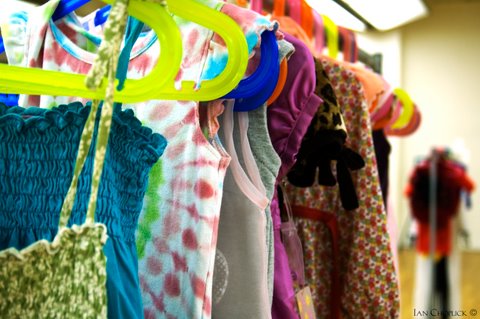When I attended my first clothing swap a few months ago, I had no idea I was taking part in a growing social movement that has caught fire since the U.S. economic crisis hit in late 2008.
The invitation sounded too good to be true: Clean out your closet, bring whatever you no longer wear — clothes, shoes, accessories — and take home whatever you find that you like. Anything left over at the end is donated to Goodwill. No money exchanged. No quid pro quo regarding how much you bring vs. how much you carry off. “It’s fun, and it’s very social,” said Alix Madrigal, a friend who is part of a group that has held swaps for 20 years. “You should come.”
I had worked in an office with Alix for years, and when I’d compliment her on some stylish thing she was wearing, she’d invariably respond, “Oh, I got it at the clothes swap. Isn’t it great? I could never afford to buy this!”
Swappers at a ClothingSwap.com event at Paradise Lounge in San Francisco. Photo credit: Gene Kosoy.
What her friends do in Marin County, Calif. every spring and fall on a small scale — usually with about 15 people and lasting three hours — is being done in numerous variations all over the country, online and off. The first National Swap Day was January 22.
And people are swapping more than clothes. There are swaps of books, DVDs, toys, tools, baby gear… even a homemade soup swap. Some have formal rules about how much you bring or take away; some online ones have a system of credits to redeem and have nominal shipping or participation fees. But what all swaps have in common is free merchandise, usually gently used.
Live clothes swaps are the most popular and most easily organized since everyone has a closet to go through, and women love to shop and update their wardrobes. (Although some swaps include men’s and children’s clothes, too.)
Clothing swaps break down into three types: those organized among friends and acquaintances for free; those designed to raise money for a cause; and those with extras like spa treatments, where a small cover charge goes to cover the cost of the event, usually with a portion going to charity. In every case, clothes left untaken are donated to a local charity.
For some, the green value of re-using clothes is the driving force. The S.W.A.P. Team, a Toronto non-profit with chapters in several Canadian cities, as well as Boston and North Hampton, Mass. and Lausanne, Switzerland, is entirely run by volunteers and, according to their website, has exchanged 23,000 pieces of clothing since launching in 2009. Through their giant Take Off Your Clothes events, “a mix of music, fashion, and community,” they have given 21,000 items to charities that donate to people in need, and have kept an estimated 44,000 items out of landfills.
San Francisco based ClothingSwap.com was a pioneer in “green glamour” and boasts the tag line “Be good. Be green. Be glam.” Founded in 1995 by Suzanne Agasi, it offers a girls’-night-out atmosphere in three-hour Diva Eve events, often held at a night club or hotel suite, and often a fundraiser. Women can enjoy cocktails, free haircuts, make-up, manicures, and massages in addition to updating their wardrobe, all for a modest admission fee, normally $20.

ClothingSwap.com founder Suzanne Agasi at one of her San Francisco events. Photo credit: Gene Kosoy.
“I want to pamper women and reward them for cleaning out their closet,” says Agasi, who has staged 231 swaps to date. “The social aspect of my events is as important to me as women scoring free wardrobe finds while helping a local charity in need.”
At her swaps, which usually draw 150-200, people arrive with their discards to socialize and enjoy spa treatments during the first two hours while volunteer sorters lay out the clothes and accessories. (Her kids’ clothing swap in New York benefitting the Rescue Mission featured face painting for the little ones.) There are no rules about how much you must bring or can take. Her principle is “Bring what you have. Take what you love.”
She calls it couture karma: “You give up some great dress you no longer wear and you get something great back.” With a lot of women out of work or now working at home, she finds many are bringing designer suits and glitzy evening wear to swaps.
Swap for Good is a volunteer organization launched by San Francisco neighbors Orli Cotel and Brianna Cayo Cotter in February, 2010 with a mission to stop domestic violence. Its tag line is “Swap stuff. Save lives.” The site encourages hosts to stage a swap and collect $20 at the door to donate to a selected women’s shelter.
Last fall, more than 110 events in more than 20 states were registered on the site. Cotel, whose day job is deputy communications director for the Sierra Club, estimates at least $10,000 was raised for women’s shelters. For hosts who have hard time asking people for money, there’s a video on the website that hosts can show with Cotel and Cotter making the pitch.
“For shelters, even a small amount of money makes such a difference,” says Cotel. “$100 is a life-saving donation, because it can house for a night a woman who is fleeing domestic violence.”

Shoppers at a Swap for Good event. Photo credit: Sarah Peet.
The Swapaholics, a two-woman swap machine in the Boston area launched in 2008, have staged small- and large-scale swaps in various cities. Co-founders Amy “Punky” Chase, who owns a mobile vintage clothing boutique, and Melissa Massello, who edits the online Shoestring Magazine, drew 400 swappers to an event during Boston’s Fashion Week in September, 2010. Women swooped in like locusts, allowed to fill up one shopping bag each, and it was all gone in 20 minutes.
The Swapaholics are partnering with Shareable for a swap event at the South by Southwest music and film festival in Austin, Texas in March.
Chase and Massello recently joined the team at Swap.com, an online swapping business that charges $.50 or $1 plus an average $3.20 shipping fee for each swap. Swap.com members have done 1.8 million swaps of books, CDs, movies, and video games, claiming a reduced carbon footprint of 10.5 million pounds due to items recycled and reused rather than thrown away.
Swap.com CEO Jeff Bennett says the Internet and social networking are expanding the opportunity to swap. “Geography is no longer an inhibitor,” he says. “It only improves the market of people who can participate.”
He says the ultimate goal is to build a community of swappers offline and online. “We’ve all lived through this binge of consumption and we’re sitting on all this stuff. Now people are thinking, ‘I can use the stuff I have to get the stuff I need.’ ”
Here are links to some websites that facilitate or encourage the swapping of various types of merchandise:
Clothes
The S.W.A.P. Team
ClothingSwap.com
Swap for Good
The Swapaholics
Swapstyle.com
Books, CDs, Movies, Videogames
Swap.com
SwapaDVD
Bookins
Kids’ stuff
Swap Mamas
Thred Up
Toy Swap









